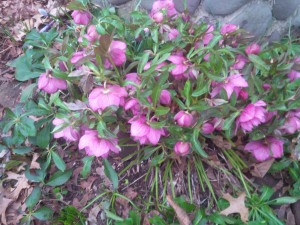Today I made a foray into the semi-snowy wasteland that is my back garden to see if I could find any hellebore buds. Recent snowfall has covered the big Christmas rose—Helleborus niger—with a white blanket. I scratched through it, but no buds have had the courage to pop out yet. Next week, after a few days of relatively balmy weather, the story may well be different. With the optimism that is a gardener’s salvation at this time of the year, I will keep looking until I find evidence of life.
In the meantime, abundant life is leaping upward from the pages of the mail order/internet catalogs that arrive every day. I am drawn to the hellebores because they will bloom early and provide a bit more visual appeal than their fellow travelers, the crocuses and snowdrops.
Hellebores, one of the least buttery members of the buttercup or Ranunculaceae family, have been around forever. One family member, the “stinking” hellebore or Helleborus foetidus, was described by sixteenth century herbalist John Gerard. It is still widely used today.
The genus has about 15 species and recent breeding advances have resulted in numerous hybrids and cultivated varieties. The most frequently available are hybrids of the Lenten rose or Helleborus orientalis. In fact, the varieties labeled “Helleborus orientalis” should really be called Helleborus x orientalis, which better describes their lineage.
Most of us care less about family trees and more about spring color, especially as long cold winters come to an end. The orientalis hybrids and varieties supply that color, in addition to a long season of bloom, attractive foliage and food for bees and other early spring pollinators. Once characterized by their relatively drab, downturned flowers, hellebores now come in an array of colors and configurations. Some of them are downright romantic, which brings me to Hans Hansen, breeder of hellebores and many other plants. In the world of hellebores, he is especially noted for two series of hellebores, “Honeymoon” and “Wedding Party”. You can’t get much more romantic or evocative than that.
Now in his forties, Hansen is Director of New Plant Development for Walters Gardens, a family owned nursery and plant breeding business in Zeeland, Michigan. He has been working with plants since his teens and has introduced new varieties of stalwarts like agave, hibiscus, peony hosta, monarda and baptisia. Judging by his introductions within those plant groups, Hansen looks for sturdy specimens with interesting color and form.
Hansen’s hellebores certainly fit those categories. The Honeymoon series features single flowers with six overlapping petals apiece. The color range is wide and includes shades of apricot, near-black, purple, white, yellow, red, and pink. Many of the varieties are bi-colors or feature contrasting markings. Honeymoon ‘Rio Carnival’, for example bears striking red petals edged in cream. ‘Spanish Flare’, another bi-color, bears cream-yellow petals with a central red “flare “erupting from each blossom’s throat.
Some truly romantic gardeners would argue that only double-flowered varieties live up to their aesthetic ideals. For them Hansen has created the Wedding Party series, featuring an abundance of colorful petals in the same shades as the Honeymoon hellebores. ‘Flower Girl’ is true to its name, with a double set of blush pink petals lightly kissed with the same palest green shade that illuminates each flower’s center. Passionate ‘True Love’ features blooms with petals that shade from dark rose to maroon. ‘First Dance’ is a flashy specimen, its double yellow petals rimmed with picotee edges of dark red.
The best thing about the Honeymoon and Wedding Party series and hellebores in general is their unfussiness. They thrive on shade and neglect and can survive drought with only occasional water. Happy plants will increase in size and frequently self-seed. My back garden is home to numerous little hellebore seedlings growing near their robust parents. I can’t wait to see what shapes and colors have resulted from cross pollination among nearby plants.
As buds and new leaves emerge in the spring, it is a good idea to remove the ragged leaves that have persisted through winter. It is not a mandatory step, but improves the plant’s appearance and makes the flowers more visible.
Hellebores are not really ideal cut flowers, but are best displayed floating in a shallow bowl of water, the better for viewers to see their unique colors and markings.
Of course, Hans Hansen is not the only breeder working on hellebores, either in the United States or Europe. The genus has attracted so much attention from gardeners and the gardening media that breeders are working 24/7 to come up with new color variations, upturned flowers, interesting leaves and other eye-catching features. It is hard to go wrong with the orientalis group, but Hansen’s are especially nice. You can order them from many nurseries, but for an excellent selection, try Plant Delights Nursery, 9241 Sauls Rd, Raleigh, NC 27603, (919) 772-4794, www.plantdelights.com. Print catalog, $7.00, with a $7.00 gift certificate mailed shortly after the catalog.

